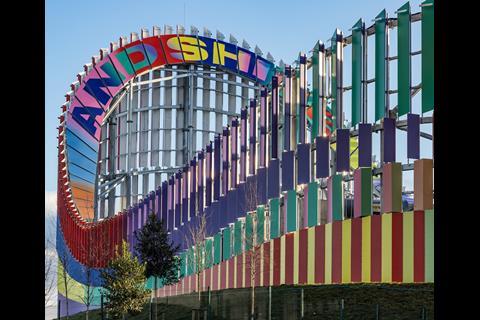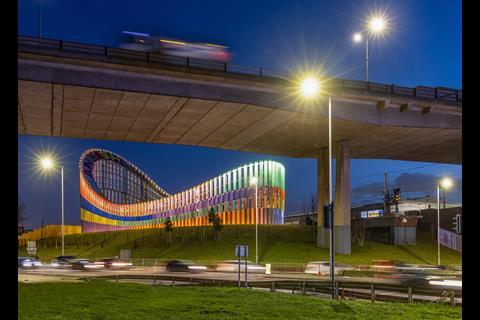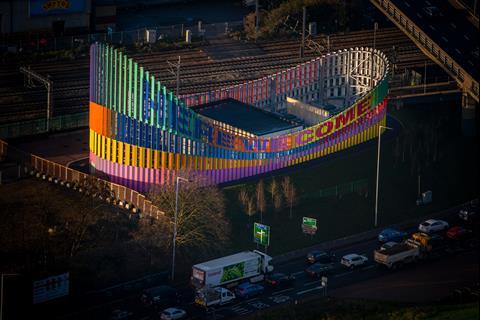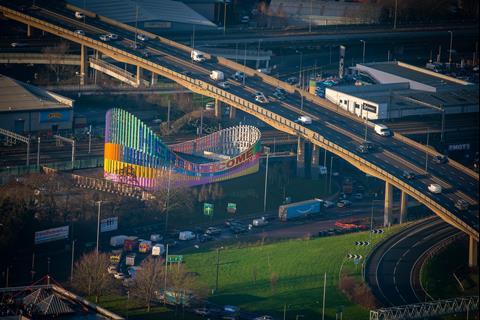The 52-metre-long permanent public artwork wraps the electrical substation at London Brent Cross Town
London Brent Cross Town, one of the largest urban regeneration projects in Europe, has had its electrical substation wrapped to create a 21-metre-high and 52-metre-long permanent public artwork.
The artwork, titled “Here we come, here we rise”, has been created by London-based artist Lakwena and architect IF_DO. The statement reflects the ambition to inspire and bring people together in the local community.
The site sits next to London’s A406 North Circular at the junction with the M1 motorway, adjacent to both the Thameslink railway line and the new Brent Cross West station, which is due to open this year.
It is estimated that six million people each year will see it from the road and rail alone.
The exuberant colour scheme and vast scale of the artwork, which at its highest point is taller than the Angel of the North (at 20 metres), ensures that it will become a local landmark.
The artwork, titled “Here we come, here we rise”, has been created by London-based artist Lakwena and architect IF_DO
The structure and facade design is comprised of four undulating bands and triangular-shaped “lenticular” panels that create a kaleidoscopic visual effect to emphasise the idea of movement.
The design team drew on influences as varied as Eadweard Muybridge’s motion studies and historic forms of roadside structures, such as billboards, funfairs and industrial sites that make use of a skeletal frame supporting a brightly coloured skin.
Brent Cross Town is being designed to be a net zero carbon development by 2030, and investment in efficient infrastructure is a key part of this.
The substation will supply electricity to all of Brent Cross Town, including the 6,700 new homes, as well as to the low-carbon district heating/cooling networks operated by Swedish energy company Vattenfall.
The design team drew on influences as varied as Eadweard Muybridge’s motion studies and historic forms of roadside structures
The electrical substation is also notable for its sustainable innovations. Global engineers, Arup, led the design team with a focus on minimising the environmental impact of the structure. The project puts circular economy principles into action with circa 50% of the structural steel being salvaged from unused oil pipelines, reducing embodied carbon emissions by over 40%.
The concrete used is a combination of low cement concrete and ‘Earth Friendly Concrete’ – a cement-free concrete. Using these alternative concrete mixes saved up to 33% and 70% of embodied carbon respectively compared to standard mixes.
Lighting plays a key part in the project, Michael Grubb Studio designed the lighting to be discreet and keep attention on the artwork. The lighting creates a halo around the facade’s wrap which filters down through the structure, allowing the light to fade away at lower level.
The project has also brought back to life a piece of brownfield, ex-industrial land with the creation of a landscaped embankment.
Newly planted trees and wildflower meadow provide a naturalistic setting, as well as increase site biodiversity and enhance local wildlife corridors.
Project details
Artist Lakwena
Architect IF_DO
Engineer Arup
Contractor Galldris
Specialist engineer Bourne Group
Lighting Michael Grubb Studio
Landscaper Gillespies Landscape Architects






















No comments yet